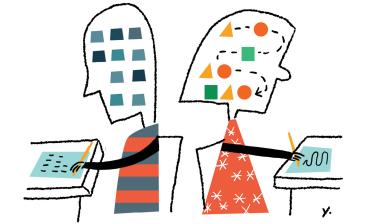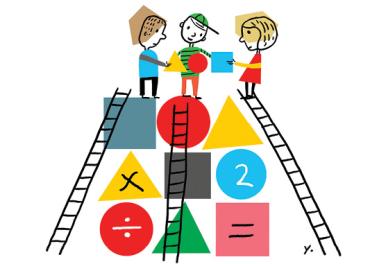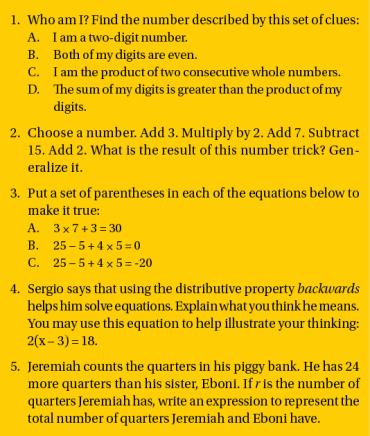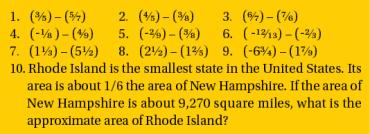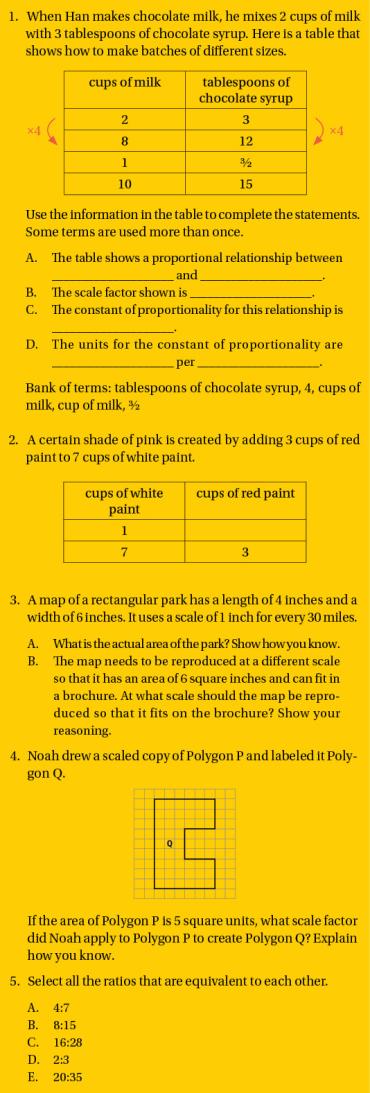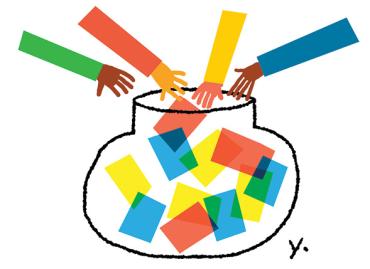When the Common Core State Standards were introduced in Illinois in 2010, teachers became very adept at planning hyper-focused units that “dove deeply” into the content and worked to develop students’ mathematical habits through the Common Core’s Standards for Mathematical Practice. It was an exciting time; as a math teacher in Illinois, I (Anne) got to solve and learn about rich tasks, there were more opportunities for cross-school collaboration than ever before, and I spent time thinking about the “how” of facilitating problem solving in my classroom.
So why, then, were my students performing so well in the short term and so poorly in the long term, when their learning and understanding of the content seemed so deep? Why did students who I taught in seventh grade swear to me in eighth grade that they had never heard of similar geometric figures, when we spent six weeks studying them and they rocked every assessment at the end of the unit?
I had thought that because we had spent ample time on content and students were able to solve complex problems on the unit assessments, that we were good. What I later realized was that I had not created opportunities for students to continue retrieving the information over time to improve and deepen their learning.
From this realization, I began to look into memory research and tried to think about ways to weave in review. Everything I came across was labeled as “spiraling,” and it seemed like a lot of work to put together things like daily warm-ups and then a lot of class time to dedicate to this separate piece of an already-packed class period.
Then, I started to notice a strategy called interleaving* in the research I was reading. After learning more about the science of learning and connecting with Pooja, a cognitive scientist, I began to understand both what the research has shown about this research-based strategy and how to implement it quickly and easily in my classroom.†
Interleaving: Simply Mix It Up
One of the most fundamental strategies in mathematics instruction is practice problems. Why? Because, as we all know, practicing a skill improves the performance of that skill. At the same time, we also know that just because students can correctly answer practice problems doesn’t mean they fully understand the concept or how to apply a formula—especially not in the long term. In other words, just because students understand a key concept in seventh grade doesn’t guarantee they’ll understand or remember the same concept in eighth grade.
How can we ensure that students are learning math and improving their skills, both in the short term and the long term? As described in the book Powerful Teaching: Unleash the Science of Learning, research by cognitive scientists demonstrates that interleaving, or the simple strategy of mixing up concepts to be learned, can increase (and even double) math learning.1
Think about a typical problem set from a textbook. A lesson on ratios, for instance, might be followed by a dozen ratio problems. This is a blocked arrangement, where problems on one concept are introduced all at once, followed by problems on a second concept, then problems on a third concept, and so on. In fact, an analysis of six popular middle school math textbooks found that more than 80 percent of the practice problems were blocked.2
Less common—but more powerful for learning—is an interleaved arrangement, where practice problems for multiple concepts are interleaved or mixed up across the problem set. For example, let’s say that students from a fourth-grade mathematics classroom are learning about the number of faces (F), edges (E), corners (C), and angles (A) of prisms. After the four concepts are taught, students could practice their understanding in two different ways (with each letter below representing one practice problem):
Blocked Problem Set: F F F F E E E E C C C C A A A A
Interleaved Problem Set: F E C A F E C A F E C A F E C A
In the blocked problem set, students complete four practice problems on faces, then four on edges, then four on corners, and lastly four on angles. In the interleaved problem set, the different types of practice problems are mixed up. Importantly, both sets have the same type and number of practice problems; they’ve simply been rearranged. What’s remarkable is that simply mixing up similar concepts in the interleaved problem set dramatically improves long-term learning compared with the blocked problem set.
Consider a simple example about baseball, from the book Make It Stick: The Science of Successful Learning. If a batter receives 10 fastballs, followed by 10 changeups (slower pitches), and then 10 curveballs, the batter will know she only has to change her batting strategy after 10 pitches. The batter literally knows what’s coming. But, if the batter doesn’t know which type of pitch is coming—if the pitches are mixed up or even random—the batter will have to choose which batting strategy works best for each pitch.3
Interleaving is not only powerful for learning; it’s flexible, too. This strategy has been shown to improve the learning of math concepts as diverse as fractions, algebra, calculus, and geometry.4 It promotes learning for students ranging from elementary and middle school to college. In fact, interleaving is also beneficial for nonmath skills, including learning foreign language vocabulary, remembering song lyrics, associating artists with their paintings, and identifying types of birds.5
I (Anne) assigned weekly homework to my eighth-grade classes, which consisted of five problems. The first two problems were related to what we were studying the current week, and the other three problems related to content learned last week, last month, and last year. By interleaving related problems from previous learning, students had to discriminate and select appropriate strategies to use to solve the problems.
Here are examples of interleaved problems we solved when working to connect number play with expressions and equations:
The memories triggered by interleaving were perhaps best summed up by a student who wrote in a reflection, “I liked weekly homework because it reminded me of stuff I knew really well before but had kind of forgotten. When I remembered it, it made learning the new stuff easier and it made more sense.”
We wish to emphasize that interleaving in math does not mean teachers must create problem sets from scratch. If you assign students practice problems from a textbook, assign related problems from previous chapters and the current chapter. There is no need to change the problems—simply mix up what you assign.
Research on Interleaving
In the example above, where fourth-graders were learning about prisms, researchers found that test performance immediately after practice problems was higher for the blocked condition. After just 24 hours, however, interleaved practice led to significantly greater test performance (77 percent) compared with blocked practice (38 percent).6
In another research study, seventh-grade students were learning about graphs and slope. After 24 hours, students who completed interleaved practice problems outperformed students who completed blocked practice problems by more than a letter grade (80 percent vs. 64 percent). Even more dramatically, after one month, test performance for the interleaved group was almost double compared with performance for the blocked group (74 percent vs. 42 percent).7
In a recent study, nearly 800 seventh-grade students in Florida completed math worksheets throughout the semester that contained interleaved problems or blocked problems related to circles, graphs, inequalities, and expressions.8 On a final test one month later, students in the interleaved group scored significantly greater (61 percent) than students in the blocked group (38 percent). Across these studies, and many more, the evidence for interleaving is clear: simply rearranging practice problems can make a large impact on students’ long-term mathematics learning.
Researchers refer to the benefits from interleaving as a “desirable difficulty.” As teachers and students know, when learning is challenging, it “sticks” and becomes more permanent. When teachers interleave history concepts (e.g., key events from the French Revolution and Russian Revolution), science concepts (e.g., mitosis, meiosis, and fission), or concepts from other content areas, students must engage in “retrieval practice” to think carefully, pull information out, and practice what they know.
Keep in mind that because of these desirable difficulties, interleaving may lead to lower initial performance on practice problems, giving the impression that interleaving is ineffective. As we described earlier, what works best for learning in the short term (blocked practice) does not guarantee learning in the long term!
We surveyed hundreds of educators around the world about interleaving and asked the following question: “Why are interleaved practice problems (ABC ABC ABC) more beneficial for learning than blocked practice problems (AAA BBB CCC)?”§ Here are some of the ideas that teachers shared:
- Blocked practice becomes repetitive about procedure. With interleaving, you have to switch gears when thinking about each type of question.
- Interleaving forces retrieving both what type of question it is and what to do with that type of question.
- With interleaving, greater effort is required for retrieval, and greater effort means greater learning.
- Interleaving helps students down the road when they need to decide which process to use in solving a problem.
- Interleaving encourages deeper processing during each practice set, and also more accurate monitoring of your learning progress.
- Interleaving helps get rid of that familiarity that comes with repeated practice, minimizing the illusions of competence and mastery.
The Key to Interleaving: Discrimination
Why does the rearrangement of practice problems enhance mathematics learning? It’s because interleaving promotes discrimination, and the key to interleaving is mixing up similar ideas.
Consider this first example, where two problems look similar yet require subtly different strategies:
In a second example, math problems could look different but require the same strategy. Below is a blocked assignment from an eighth-grade mathematics textbook.9 After students solve problems 1–9, which explicitly require multiplication, students can correctly assume that problem 10 (a word problem) also requires multiplication.
In this second example, students can solve the word problem without reading any words.** If an entire problem set requires the same procedure or strategy, students can safely “plug and chug” without thinking about what they need to do.
For interleaving, it’s not the format of the practice problems that matters; it’s the underlying concepts. If you want students to discriminate carefully, interleave practice problems that look alike but require different strategies.10
Try interleaving for yourself. What are the answers for these problems?
- A bug flies 48 miles east and then 20 miles south. How far is the bug from where it started?
- A bug flies 48 miles east and then 14 miles north. How far is the bug from where it started?
- A bug flies 48 miles east and then 6 miles west. How far is the bug from where it started?
We posted these interleaved practice problems online, and of more than 250 responses, 65 percent of teachers got the first problem correct, 59 percent of teachers got the second problem correct, and 93 percent of teachers got the third problem correct.††
Did you notice what’s different about the third problem? It requires simple subtraction! We’re glad teachers in our survey didn’t fall for the subtle switch from the Pythagorean theorem to subtraction, but chances are your students won’t be as savvy without more interleaved practice.11
I (Anne) also use problems from my curriculum (Illustrative Mathematics) to interleave opportunities for eighth-grade students to select strategies as part of their independent practice, like the problems below.12
All of the problems in the above example are related to the broad topic of proportional reasoning, but they have nuances that call for different methods to solve. These nuances help students discriminate and tap into prior learning, and both my students—and I—saw a difference. Students were more confident about the current learning in this content strand and were more thoughtful about how they solved problems. This change was a huge shift for some students who previously relied on whatever method was discussed in class most recently to solve any problem they were given.
Keep in mind that mixing everything up doesn’t mean it’s always beneficial for learning. One study indicated that mixing up different course subjects—for example, chemistry and history—does not increase learning.13 Why not? Simply because this doesn’t involve discrimination; the content areas are too different. As another example, think of a fruit salad that’s full of blueberries, strawberries, and raspberries. Would you add carrots or broccoli? Probably not! It’s important to interleave similar concepts so students really have to think about the subtle differences. When students really have to think, this challenges learning—which boosts learning.14
Planning for retrieval practice became a regular part of my unit planning. I (Anne) worked to gather screenshots of freely available online problems and organized them into files that helped me quickly grab what I needed for specific content. The materials I formerly used to create graded quizzes, I repurposed for interleaving opportunities. I laid out my units with students’ assumed prior knowledge in mind so that these power tools could help them access material they had stored somewhere in their memories.
The key, for me, was to use what I had—just better. I had seen conversations about “spiral review” on Twitter and in instructional materials, but it always seemed like a ton of work to create all these new warm-ups, and purchasing new instructional materials was neither a desire nor an option. So, instead, I looked at how my students progress through grades 5–9 in my context and organized banks of problems I already had (and liked) so that they could be used for interleaving.
The changes I saw in our classroom culture and the shifts students made in long-term learning and the ability to demonstrate that learning were amazing, and it took remarkably little effort on my or their part. By organizing information in more meaningful ways, and applying power tools that are supported by cognitive science research, we can lessen the pressure and strengthen the confidence, joy, and performance in our classrooms.
Pooja K. Agarwal is a cognitive scientist and coauthor of Powerful Teaching: Unleash the Science of Learning. Anne Agostinelli is a seventh- and eighth-grade math teacher in the Chicago Public Schools. Follow them on Twitter @RetrieveLearn and @AnneAgost.
*For resources on interleaving, visit www.retrievalpractice.org/interleaving. (return to article)
†For more on interleaving and other strategies, see “Strengthening the Student Toolbox” in the Fall 2013 issue of American Educator, available at www.aft.org/ae/fall2013/dunlosky. (return to article)
‡Answers to the set of problems 1-5 above:
1. 20
2. The result will always be twice the starting number.
3. 3 × (7 + 3) = 30
25 − (5 + 4 × 5) = 0
25 − (5 + 4) × 5 = -20
4. Sergio means that solving equations is “undoing” the steps it took to set up the
equation. In this example, he could divide by 2 first, then add 3 to get that x = 12.
5. r + (r − 24) (return to article)
§This survey is available at www.retrievalpractice.org/interleaving-survey. (return to article)
**The correct answer for problem number 10 is 1,545 square miles. Calculating the answer requires the same procedure as problems 1–9: multiplication. (return to article)
††The correct answers are 52, 50, and 42, respectively. For more interleaving practice problems, visit www.retrievalpractice.org/interleaving-practice. (return to article)
Endnotes
1. P. K. Agarwal and P. M. Bain, Powerful Teaching: Unleash the Science of Learning (San Francisco: Jossey-Bass, 2019).
2. D. Rohrer, R. F. Dedrick, and P. K. Agarwal, “Interleaved Mathematics Practice: Giving Students a Chance to Learn What They Need to Know,” University of South Florida, 2017, www.retrievalpractice.org/interleaving.
3. P. C. Brown, H. L. Roediger, and M. A. McDaniel, Make It Stick: The Science of Successful Learning (Cambridge, MA: Harvard University Press, 2014).
4. D. Rohrer, R. F. Dedrick, and S. Stershic, “Interleaved Practice Improves Mathematics Learning,” Journal of Educational Psychology 107 (2015): 900–908.
5. P. Carvalho and R. Goldstone, “When Does Interleaving Practice Improve Learning?,” in The Cambridge Handbook of Cognition and Education, ed. J. Dunlosky and K. Rawson (Cambridge: Cambridge University Press, 2019), 411–436.
6. K. Taylor and D. Rohrer, “The Effects of Interleaved Practice,” Applied Cognitive Psychology 24 (2010): 837–848.
7. Rohrer, Dedrick, and Stershic, “Interleaved Practice Improves Mathematics Learning.”
8. D. Rohrer et al., “A Randomized Controlled Trial of Interleaved Mathematics Practice,” Journal of Educational Psychology, advance online publication, http://dx.doi.org/10.1037/edu0000367.
9. D. Rohrer, “Interleaving Helps Students Distinguish among Similar Concepts,” Educational Psychology Review 24 (2012): 355–367.
10. S. C. Pan, “The Interleaving Effect: Mixing It Up Boosts Learning,” Scientific American, August 4, 2015.
11. D. Rohrer, R. F. Dedrick, and K. Burgess, “The Benefit of Interleaved Mathematics Practice Is Not Limited to Superficially Similar Kinds of Problems,” Psychonomic Bulletin & Review 21 (2014): 1323–1330.
12. Open Up Resources, “Lesson 2: Introducing Proportional Relationships with Tables,” https://access.openupresources.org/curricula/our6-8math/en/ccss/grade-7….
13. H. Hausman and N. Kornell, “Mixing Topics while Studying Does Not Enhance Learning,” Journal of Applied Research in Memory and Cognition 3 (2014): 153–160.
14. D. Rohrer, “Interleaving Helps Students Distinguish.”

